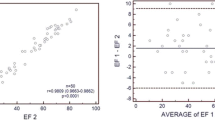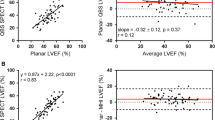Abstract
Background: Quantitative determination of ejection fraction is predicated on precise measurement of end-diastolic and end-systolic volumes of the left ventricle. Contrast enhanced electron beam tomography (EBT), with excellent temporal and spatial resolution, has the potential for highly accurate measures of ejection fraction. Methods: EBT protocol used a short axis scan of the left ventricle (8–12 levels, apex to base) during infusion of iodinated contrast. To assess the accuracy of the measured left ventricular ejection fraction (LVEF), we compared EBT with first-pass radionuclide angiography (RNA) and cine angiography (CINE). Results: A total of 41 patients (26 men and 15 women) underwent all three tests within 1 week. Resting ejection fraction using each modality was assessed in a linear regression model to assess inter-test correlation with the other two modalities. Correlation between CINE and EBT was high (r = 0.90, intercept 4.67, p < 0.001). Similarly, correlation of CINE and RNA (r = 0.87, intercept −5.48, p < 0.001) and between EBT and RNA (r = 0.87, intercept −4.6, p < 0.001) were high. In a subset of those patients with LVEF ≤ 40%, correlation was consistently high between EBT and CINE. However, correlations were poor for the comparisons between RNA and CINE (r = 0.40), and between the RNA and EBT (r = 0.47). The mean differences of measured ejection fractions between each of the imaging modality were small. However, there was only modest agreement between each of the comparisons as measured using 95% confidence interval (CI) on Bland–Altman plots. Conclusion: These data indicate that the LVEF results are comparable among EBT, RNA, and CINE and can be used interchangeably to assess ventricular function for LVEF > 40%. For LVEF ≤ 40%, we demonstrated some disparate results between cine angiography and RNA and between EBT and RNA, indicating that CINE or EBT may provide more accurate assessment.
Similar content being viewed by others
References
Hammermeister KE, DeRouen TA, Dodge HT. Variables predictive of survival in patients with coronary disease: selection by univariate and multivariate analyses form the clinical, electrocardiographic, exercise, arteriographic, and quantitative angiographic evaluations. Circulation 1979; 59: 421–430.
Marcus ML, Stanford W, Hajduczok ZD, Weiss RM. Ultrafast computed tomography in the diagnosis of cardiac disease. Am J Cardiol 1989; 64: 54E–59E.
Rich S, Chomka EV, Stagl R, Shanes JG, Kondos GT, Brundage BH. Determination of left ventricular ejection fraction using ultrafast computed tomography. Am Heart J 1986; 112: 392–396.
MacMillan RM, Rees MR, Weiner R, Maranhao V. Assessment of global and regional left ventricular function in ischemic heart disease using ultrafast computed tomography. Cathet Cardiovas Diag 1988; 14: 248–254.
Bleiweis MS, Georgiou D, Brundage BH. Ultrafast CT and the cardiovascular system. Int J Card Imaging 1992; 8: 289–302.
Budo. MJ, Gillespie R, Georgiou D, et al. Comparison of exercise electron beam computed tomography and sestamibi in the evaluation of coronary artery disease. Am J Cardiol 1998; 81: 682–687.
Wolfkiel CJ, Ferguson JL, Chomka EV, Law WR, Brundage BH. Determination of cardiac output by ultrafast computed tomography. Am J Physiologic Imaging 1986; 1: 117–123.
Roig E, Chomka EV, Castaner A, et al. Exercise ultrafast computed tomography for the detection of coronary artery disease. J Am Coll Cardiol 1989; 13: 1073–1081.
Rumberger JA, Behrenbeck T, Bell MR, et al. Determination of ventricular ejection fraction: a comparison of available imaging methods. Mayo Clin Proc 1997; 72: 860–870.
MacMillan RM, Rees MR, Maranhao V, Clark DL. Comparison of left ventricular ejection fraction by cine computed tomography and single plane right anterior oblique ventriculography. Angiology 1986; 37(4): 299–305.
MacMillan RM, Rees MR. Determinants of left ventricular ejection fraction by ultrafast computed tomography. Angiology 1988; 39: 203–210.
Rumberger JA, Lipton MJ. Ultrafast cardiac CT scanning. Cardiology Clinics 1989 Aug; 7(3): 713–734.
Chomka EV, Brundage BH. Evaluation of left ventricular function by exercise bicycle ergometry ultrafast computed tomography. Ultrafast Computed Tomography in Cardiac Imaging: Principles and Practice. Mount Kisco, NY: Futura Publishing Co. Inc. 1992: 239–249.
Thompson BH, Stanford W. Evaluation of cardiac function with ultrafast computed tomography. Radiologic Clinics of North America 1994; 32: 537–551.
Senior R, Sridhara BS, Basu S, et al. Comparison of radionuclide ventriculography and 2D echocardiography for the measurement of left ventricular ejection fraction following acute myocardial infarction. European Heart J 1994; 15: 1235–1239.
Reiter SJ, Rumberger JA, Feiring AJ, Stanford W, Marcus ML. Precision of measurements of right and left ventricular volume by cine computed tomography. Circulation 1986; 74(4): 890–900.
Pietras RJ, Wolfkiel CJ, Veselik K, Roig E, Chomka EV, Brundage BH. Validation of ultrafast computed tomographic left ventricular volume measurement. Invest Radiol 1991; 26: 28–34.
Basilico FC, Folland ED, Karaffa S, Tow DE, Parisi AF. Non-invasive measurement of left ventricular function in coronary artery disease. Comparison of first pass radionuclide ventriculography M-mode echocardiography, and systolic time intervals. Br Heart J 1981; 45: 369–375.
Gottsauner-Wolf D, Schedlmayer-Duit J, Porenta G, et al. Assessment of left ventricular function: comparison between radionuclide angiography and semiquantitative two-dimensional echocardiographic analysis. European Journal of Nuclear Medicine 1996; 23: 1613–1618.
Kaul S, Boucher CA, Okada RD, Newell JB, Strauss HW, Pohost GM. Sources of variability in the radionuclide angiographic assessment of ejection fraction: a comparison of first-pass and gated equilibrium techniques. Am J Cardiol 1984; 53: 823–828.
Budo. MJ, Georgiou D, Brody A, et al. Ultrafast computed tomography as a diagnostic modality in the detection of coronary artery disease: a multicenter study. Circulation 1996; 93: 898–904.
Aichenbach S, Moshage W, Ropers D, Nossen J, Bachman K. Non-invasive three dimensional visualization of coronary artery bypass grafts by electron beam computed tomography. Am J Cardiol 1997; 79: 856–861.
Franciosa JA, Wilen MW, Ziensche S, Cohn J. Survival in man with severe chronic left ventricular failure due to coronary heart disease or idiopathic dilated cardiomyopathy. Am J Cardiol 1983; 51: 831–837.
Marzullo P, L‚Abbotte A, Marcus ML. Patterns of global and regional systolic and diastolic function in the normal right ventricle assessed by ultrafast computed tomography. JACC 1991; 17: 1318–1325.
Feiring AJ, Rumberger JA, Reiter SJ, et al. Sectional and segmental variability of left ventricular function: experimental and clinical studies using ultrafast computed tomography. J Am Coll Cardiol 1988; 12: 415–425.
Dodge HT, Sandler H, Ballew DW, Lord JD Jr. The use of biplane angiocardiography for the measurement of left ventricular volume in man. Am Heart J 1960; 60: 762–776.
Bland JM, Altman DG. Statistical methods for assessing agreement between two methods of clinical measurement.
Author information
Authors and Affiliations
Rights and permissions
About this article
Cite this article
Baik, H.K., Budoff, M.J., Lane, K.L. et al. Accurate measures of left ventricular ejection fraction using electron beam tomography: A comparison with radionuclide angiography, and cine angiography. Int J Cardiovasc Imaging 16, 391–398 (2000). https://doi.org/10.1023/A:1026536510821
Issue Date:
DOI: https://doi.org/10.1023/A:1026536510821




